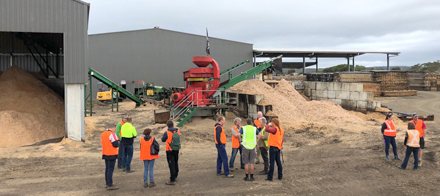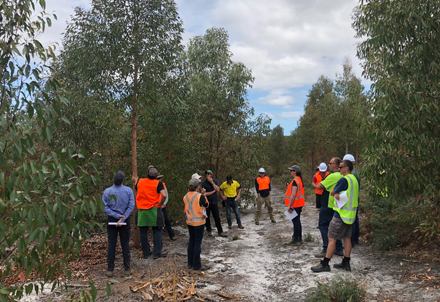
Field visit to the recently commissioned Radial Timber Australia sawmill in Yarram
Several groups from around Australia who are growing durable hardwoods trees recently got together for a conference. It was a great learning curve for all. The forum, which took place at Yarram in Victoria’s South Gippsland, was hosted by Heartwood Plantations, which is growing durable hardwood plantations for the new radial saw mill at Yarram. Source: Philip Hopkins for Timberbiz
“I love being challenged – it brings a fresh approach,” said Heartwood owner Jon Lambert.
Helping generate the new ideas were Super Forest Plantations and Hurfords from northern NSW, the Private Forestry Service from Queensland and the New Zealand Dryland Forest Initiative.
“We have all got different climates, targets, soils and species. No one is 100 per cent right or wrong – we are all trying to figure it out. The robust comments about why you doing what you are doing, was fantastic,” he said.
Heartwood is growing yellow stringy bark, silvertop ash and southern mahogany, while Hurfords is more focussed on ironbark, spotted gum and blackbutt.

Inspection of a 4-year-old spotted gum and yellow stringybark plantation managed by Heartwood Plantations
Super Forest Plantations, for example, was growing seedlings for five or six species and mixing them in the trays, said Jon. They had tried everything from rainforest species to iron barks, grey gums and other highly valued timbers such as mahogany.
“No two trees in a row are the same, and they are all class 1 or 2 durables. They are not constrained by big commercial size, and have started cultivating up and down hills with spot cultivators,” Mr Lambert said.
Because species mixtures were so interesting, Heartwood had changed its direction. “We no longer plant single species. We are not going to the extent they are, but for risk management, we are trying to mix two species,” he said.
“Frost has destroyed so many of our plantations in recent years, having a species that is not as frost sensitive, is quite wise. Drought, nutrition, insects – one can be hammered and the other not touched.”
This brought different management challenges, but the benefits outweighed these.
“It gets back to what nature tells us about eucalypts – pure species are often found in mixtures,” Mr Lambert said.
There had also been a lot of learning around integrating with animals.
“We are doing a lot of that and the NSW guys are doing the same,” he said.
Much pine or short rotation eucalypts relied on heavy stockings and fairly low intensity management, with weeds underneath.
“When growing durable hardwoods, thinning and pruning regularly, you have light coming in to the ground. That means weeds, particularly in the Strzelecki Ranges,” Mr Lambert said. In NSW, they were dealing with massive lantana in their plantations.
“The focus is on how to convert the inter-rows into pasture to eliminate the noxious weeds and be productive for cattle,” he said.
“Heartwood Plantations now has Heartwood Herds, which is set up for the main reason – we have more than 300 cattle and sheep, gradually dong the same thing at a lot of our sites. You realise, they have to work together.”
While South Gippsland and northern NSW used different breeds of cattle and sheep, the fencing and land management challenges were the same, said Mr Lambert – “which bits to potentially leave and not put trees on, and not having to plant all those steep slopes where it’s twice as expensive to do something”.
“It endears us more to the farming communities – they see livestock, activity, management,” he said.
Another issue was ‘What do we do with the thinnings’? Box, half posts, round posts, firewood, woodchips, biomass – all were exploring this issue.
Each group had its own challenges.
“In NSW, they have a big challenge with harvesting – there are lots of little roads, few bridges with local ratings – how to get the wood out? Local government will not pay for bridges. Nimbin and those places are nearby, so there is a big green influence and pressure,” Mr Lambert said.
“We have blackberries and ragwort, they have lantana. We have nutrient problems. They have less of that, with their good growing conditions, but they have disease Ramularia – a pathogen that attacks the tips of trees on spotted gum and essentially destroys them.”
All groups had one common experience – “a total denial we exist”, said Mr Lambert. “We are totally alone in doing this. There are no funds through official aid channels. We don’t want to complain – but just get on with it.”
A big thing was new friendships.
“We met some really good people doing similar stuff – that’s important,” Mr Lambert said.
All are participated in a durability study at Innisfail comparing native forest and plantation. The humidity of Innisfail speeds up the process, providing an accelerated environment for durability. “We cut timber samples, put them in the ground and check them every few years to see what the decay is like,” Mr Lambert said.
“If the plantation results are good, the question then arises: can we slip them in with the existing product? Will they be as strong and durable? No one is doing the work on this.”
The forum will be held again next year, in northern NSW.
“If other grows are out there, in Western Australia or Tassie – come and get involved. We are all trying to do the same thing. It’s a give-take relationship, which is why it’s invitation only,” Mr Lambert said.





